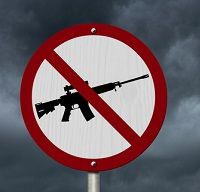Article
Lesson from Down Under: Assault-Gun Ban Ended Mass Shootings
Author(s):
In the search for answers to US gun violence there are renewed calls to limit the sale of rapid-fire weapons. That worked in Australia, researchers report.

Gun violence in the US has been labeled a public health crisis, and medical organizations including the American Medical Association are lobbying Congress for new laws to restrict gun sales.
That worked in Australia.
In a study published online today in the Journal of the American Medical Association, Australian researchers report dramatic results in a reform that might be difficult to enact in the US: banning rapid-fire weapons sales.
The Australian government also enacted a buy-back program to get gun-owners to turn in these weapons. Possession now carries criminal penalties.
The result: there were no fatal mass shooting from 1997 through May 2016. The call to disarm was enacted in 1996.
In the 18 years preceding the ban, there had been 13 mass shootings.
The researchers were unable to determine whether an accompanying decline in the rate of firearms deaths in general during the post-reform years was attributable to halting the sales of rapid-fire weapons.
Still, there was no arguing with the conclusion of study authors Simon Chapman, PhD and colleagues that “following enactment of gun law reforms in Australia in 1996, there were no mass firearm killings through May 2016.” The authors work at the School of Public Health at the University of Sydney and the Department of Psychology, Macquarie University, both in Sydney, AU.
Though the gun sale reforms were limited to semi-automatic and pump-action rifles and shotguns, during a government buy-back period, many gun-owners also surrendered handguns and other weapons that remained legal—without getting monetary compensation.
The researchers found that suicide deaths also declined after the reforms by a total of 1.5%, including suicides by any means, not just gunshot. That is likely because people attempted suicide by less fatal means and lived, the researchers said.
Immediately after the laws were passed, there was surge in purchase of guns that remained legal. But that was offset by the drop in sales of assault weapons, and the voluntary surrenders of other guns. “The proportion of Australian households reporting private gun ownership declined by 75% between 1988 and 2005,” the team noted.
The impetus for the reforms was an incident in Tasmania 1996 where 35 people were fatally shot.
The study was accompanied by a JAMA editorial calling for action.
“Australian citizens, professional organizations, and academic researchers all played productive roles in developing and promoting evidence-informed policies and demanding that their lawmakers adopt measures to prevent the loss of life and terror of gun violence,” Daniel Webster, ScD, MPH of the Johns Hopkins Bloomberg School of Public Health’s Center for Gun Policy and Research concluded. “Citizens in the United States should follow their lead.”





